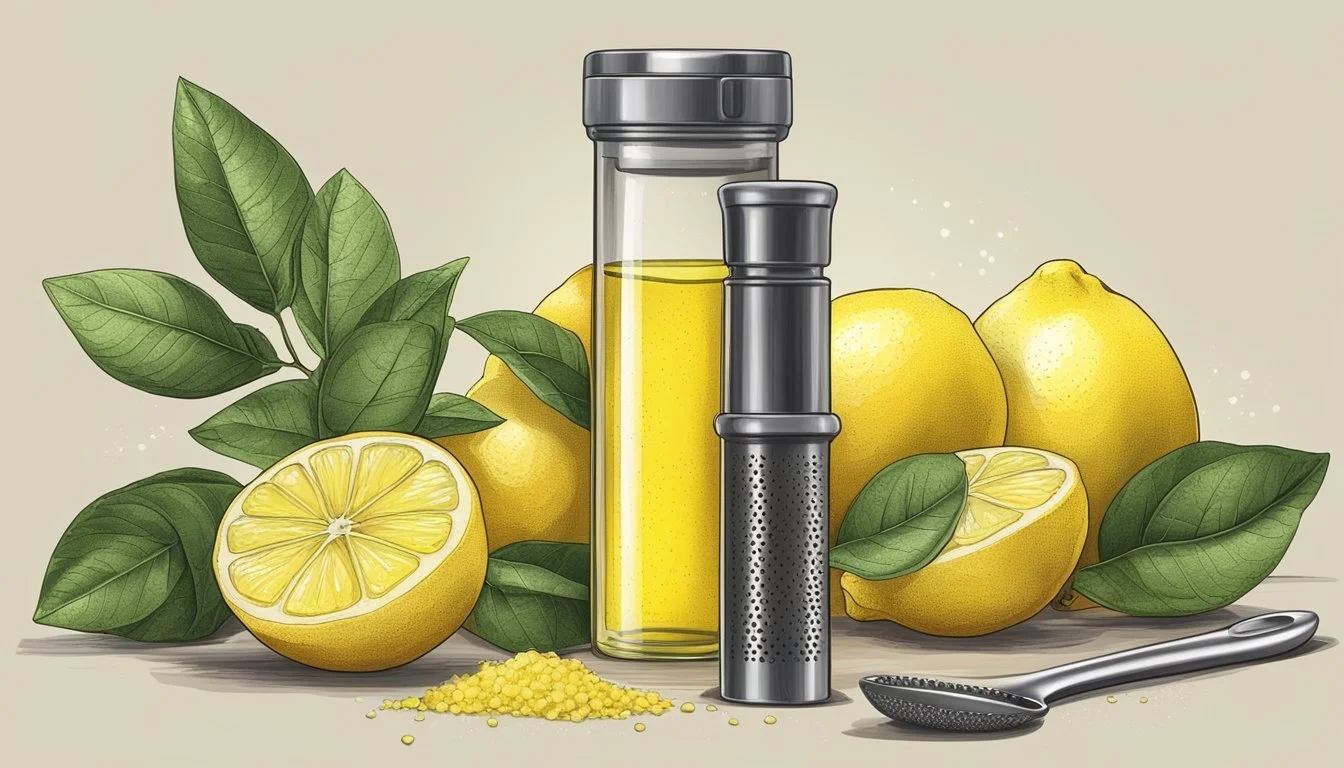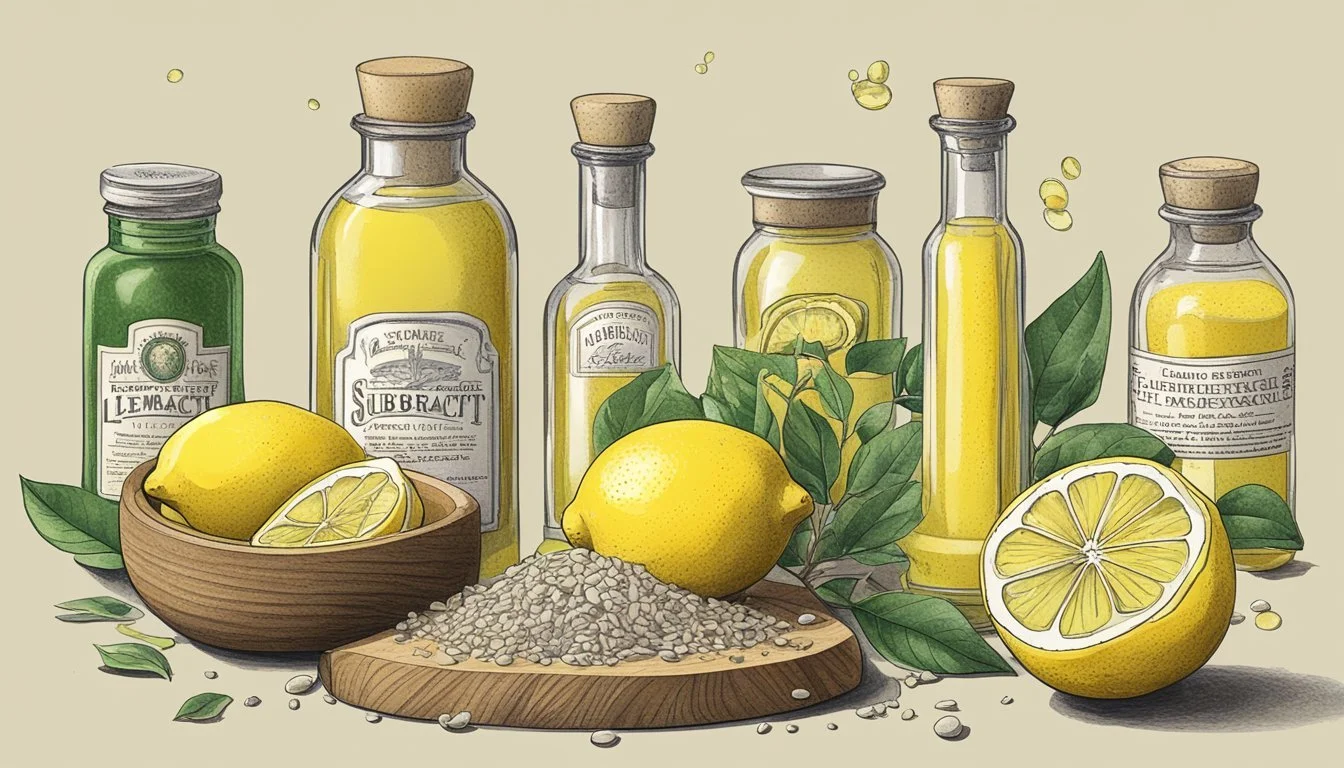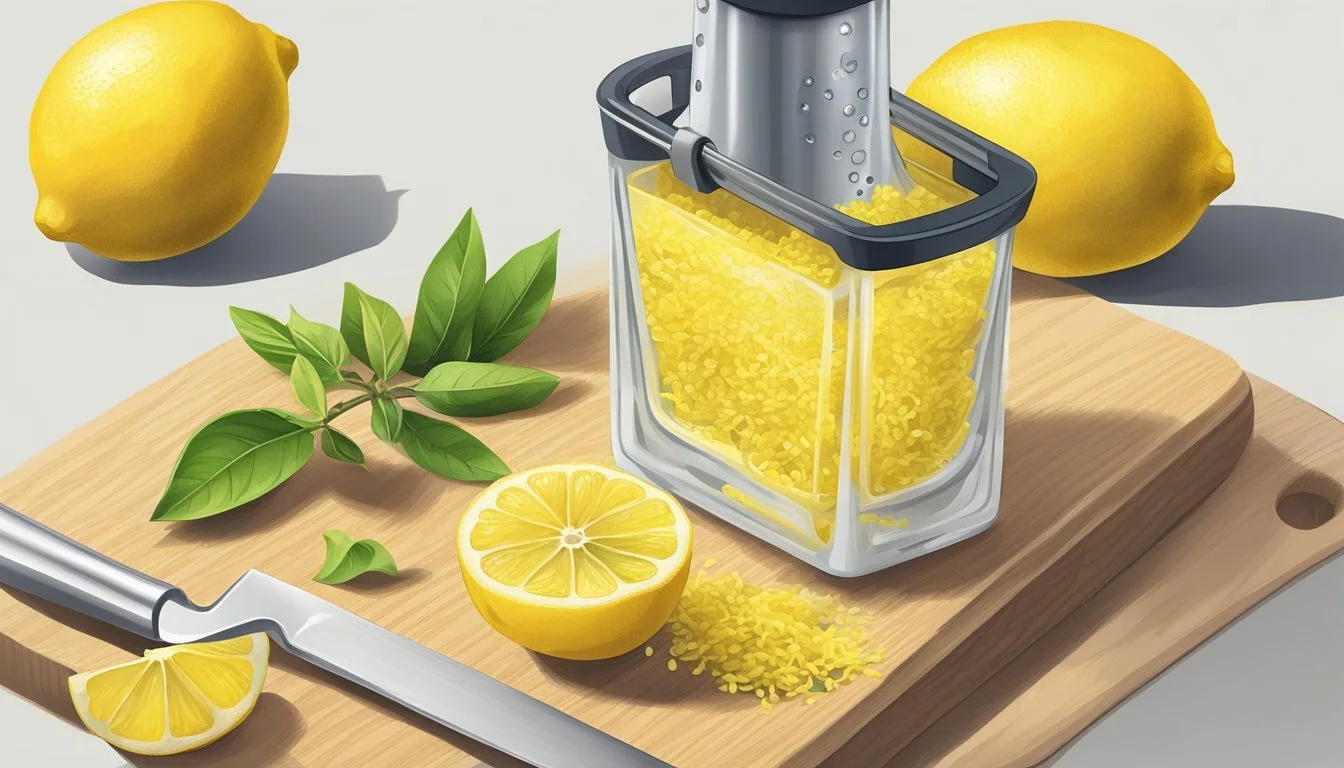How to Substitute Lemon Extract for Lemon Zest
A Simple Conversion Guide
Lemon zest, the colorful and aromatic outer layer of a lemon's rind, is a common ingredient in a variety of recipes, from baked goods to savory dishes. It provides a bright, citrusy flavor that can elevate the overall taste of a dish. However, there are times when lemon zest may not be readily available, and cooks need to find a suitable substitute to maintain the integrity of their dish.
Lemon extract is a highly concentrated flavoring made from lemon oil, which can be used as an alternative to lemon zest. It offers a strong lemon flavor without the tartness of fresh lemon juice, making it an appropriate substitute in recipes where lemon zest is called for. When using lemon extract to replace lemon zest, it is important to consider the potency of the extract and adjust the quantity accordingly to avoid overpowering the dish.
While the primary role of lemon zest is to add depth and a burst of lemon flavor, substituting with lemon extract requires a careful hand. Generally, a smaller amount of lemon extract is needed compared to the amount of lemon zest called for in the recipe. This ensures that the vibrant lemon flavor is present without being too intense.
Understanding Lemon Zest and Its Role
In the culinary world, lemon zest is known for its ability to impart fresh, tangy flavor to various dishes, from sweet to savory. Its unique properties and applications render it a pivotal ingredient in many recipes.
Origins and Uses in Cuisine
Lemon zest is the outermost rind of the lemon, carefully removed to avoid the bitter white pith underneath. Method of extraction: Typically, a zester or grater is used to zest a lemon.
Uses:
Baking: Adds a lemony nuance to cakes, cookies, and pastries.
Sauces and salad dressings: Contributes a bright, citrusy note.
Salads: Enhances the overall flavor profile with its fresh aroma.
It's important not to confuse the zest with fresh lemon juice, which is more acidic and does not provide the same fragrant oils as the zest.
Nutritional Value and Flavor Profile
Lemon zest offers a distinct flavor profile that is aromatic and less acidic than fresh lemon juice. The zest contains the fruit's essential oils, which are responsible for that strong citrus scent.
Nutritional content:
Vitamins: High in Vitamin C.
Minerals: Contains traces of potassium and calcium.
The incorporation of lemon zest in recipes contributes not only to the flavor complexity but also to the nutritional value, albeit in small amounts due to the typical usage of zest being measured in teaspoons or tablespoons. Its role in cuisine extends beyond mere taste to a multifaceted addition that can brighten dishes and provide a subtle depth of citrus flavor.
Introduction to Lemon Extract
Lemon extract is a concentrated source of lemon flavor, used extensively in baking to impart a strong citrus essence without altering the texture of the final product. It offers a convenient way to introduce a vibrant lemon aroma and taste to a diverse range of culinary creations.
Production and Extraction Process
Lemon extract is produced by soaking lemon peels in high-proof alcohol, which absorbs the flavorful lemon oils from the zest. The solution is then strained to remove the peels, and what remains is a highly concentrated liquid known as lemon extract. This process ensures that the extract retains the robust flavor and aroma of fresh lemons.
Step Description Peeling Only the outermost layer of the lemon peel is used. Soaking Peels are soaked in alcohol to draw out the lemon oils. Straining The mixture is filtered to separate the lemon-infused alcohol. Bottling The final extract is bottled, preserving the citrus essence.
Culinary Applications and Benefits
Lemon extract is a versatile ingredient in the kitchen, especially favored in baking recipes for cookies, cakes, and pastries where a pronounced lemon flavor is desired. Its intense concentration means that only a small amount is necessary to achieve the desired citrus flavor, making it a potent alternative to fresh zest. Additionally, the alcohol content in the extract evaporates during the cooking process, leaving behind the desired flavor and aroma without additional moisture.
Cookies & Cakes: Enhances the taste with a few drops.
Icing & Glazes: Provides a lemony zing without thinning the consistency.
Candies & Desserts (What wine goes well with desserts?): Infuses a strong lemon essence throughout.
Lemon Zest Substitution Ratios
When substituting lemon extract for fresh lemon zest, it's important to establish the correct ratios to maintain the intended flavor profile and overall consistency of the finished product.
General Guidelines for Substitution
For an effective substitution, one can replace fresh lemon zest with lemon extract in a 1:2 ratio. This means that for every tablespoon of lemon zest required, a cook should use 1 1/2 teaspoons of lemon extract. This ratio is a general guide and should be adjusted to taste.
Lemon zest to Lemon extract: 1 tablespoon zest = 1 1/2 teaspoons extract
It's essential to consider the concentration of the extracts; because they are typically stronger than fresh zest, less is required to achieve a comparable flavor intensity.
Precision in Flavor and Texture
The success of swapping lemon zest with an extract relies on accurate measurements to ensure the flavor match remains as close to the original ingredient as possible. Extracts add liquid to recipes, which can affect the consistency of the finished product, while zest can impart texture as well as flavor.
Maintaining Texture: Substituting extracts may not provide the same flecks of color and texture that zest would; hence, it might change the appearance and mouthfeel of some dishes.
Flavor Concentration: Consider the potency of the extract compared to fresh lemon zest, as this can alter the dish's flavor if not measured accurately.
By adhering to these specific substitution ratios and paying close attention to the flavor and texture nuances, a chef can confidently replace lemon zest with lemon extract without significantly altering the dish's intended taste and presentation.
Lemon Extract in Different Recipe Types
When substituting lemon extract for lemon zest, it's crucial to consider the type of recipe and the role lemon flavor plays in it. The intensity of the extract means modifications are needed to maintain balance.
Baked Goods and Desserts
In cakes and desserts, the fragrant zest provides a citrus essence without adding liquid. For every tablespoon of lemon zest, use 1/2 teaspoon of lemon extract. This ratio preserves the desired lemony kick without altering the dessert's texture. In cookies or scones, the substitution should be even more conservative to avoid overpowering sweetness.
Cookies, Scones: For 1 tablespoon zest, use 1/4 teaspoon extract.
Cakes, Muffins: For 1 tablespoon zest, use 1/2 teaspoon extract.
Savory Dishes and Marinades
For savory recipes, such as lemon chicken or dressings, the zest adds a fresh zing. Lemon extract, being more potent, should be used sparingly to retain the dish’s character without dominating it. In marinades, its concentrated flavor penetrates the meat effectively.
Lemon Chicken: For 1 tablespoon zest, use 1/3 teaspoon extract.
Dressings, Marinades: For 1 tablespoon zest, use 1/2 teaspoon extract, and adjust acidity if necessary.
In all applications, one must be mindful to adapt to the intense flavor profile of lemon extract accordingly.
Tips for Using Lemon Extract as Zest
When substituting lemon extract for lemon zest, one must carefully adjust for acidity and texture to maintain the integrity of the original recipe. Precise measurement and attention to the reactiveness of other ingredients are crucial.
Adjusting the Recipe's Acidity
Lemon zest adds a fragrant citrus flavor without significantly altering a recipe's acidity. In contrast, lemon extract, which is more concentrated and acidic, can change the balance of a dish. When using lemon extract as a substitute, it's recommended to start with half the amount of zest called for and adjust to taste. For instance:
If a recipe requires 1 tablespoon of zest:
Use 1/2 tablespoon of lemon extract
Should the recipe be sensitive to changes in acidity, such as a lemon vinaigrette, it's essential to assess the overall flavor profile and reduce or omit other acidic ingredients to compensate.
Dealing with Textural Changes
Texture is another critical aspect to consider. Lemon zest provides a burst of flavor without significantly changing the consistency of a dish. Lemon extract, being a liquid, can introduce unwanted changes in texture, particularly in baked goods. To prevent such issues:
Incorporate lemon extract with other liquids in the recipe to maintain consistency.
For recipes where texture is paramount, alternatives like dried lemon peel or other citrus zests can be used in place of lemon extract to provide a zest-like texture. Add dried lemon peel in a reduced quantity due to its concentrated flavor (for every tablespoon of zest, use 1/3 tablespoon of dried lemon peel).
If the presence of citrus zest is crucial for texture, such as in baking, one might choose to use a different form of citrus zest, like lime, in equal parts as a direct substitute. However, if the recipe can do without the zest texture altogether, a few drops of lemon extract can impart a similar flavor without significant texture alteration.
Other Citrus Alternatives
When lemon zest is unavailable, other citrus fruits offer zest and juice options that can bring similar vibrancy to recipes.
Exploring Lime, Orange, and Other Options
Citrus fruits such as oranges and limes provide excellent alternatives to lemon zest. Lime zest can deliver a similar punch of citrus flavor, albeit with a slightly more tropical character compared to lemon. When substituting, lime zest can be used in a 1:1 ratio for lemon zest to maintain the citrus note in dishes. Orange zest, while distinctly sweeter, can also be a substitute and is best used in sweet pastries and dessert recipes for a softer, fruity aroma. It can replace lemon zest using equal measurements.
For a more nuanced citrus flavor, one may consider grapefruit zest. It has a bitter edge and should be used sparingly. Grapefruit zest can provide a robust citrus flavor in salad dressings or savory dishes pairing well with Mediterranean flavors like olives and fennel.
Matching Flavors with Different Citrus Zests
The key to substituting citrus zests lies in matching the flavors to the recipe's profile. Here's a brief guide:
Lime Zest: Ideal for Thai and Mexican cuisine, delivering a sharp, green note. Matches well with coconut, ginger, and cilantro.
Orange Zest: Complements baked goods, chocolate, and sweet dishes. Harmonizes with spices like cinnamon and cloves.
When substituting citrus juices like lime juice or orange juice for extracts, one must adjust for the added liquid and acidity in the recipe. A general substitution ratio is to use two tablespoons of citrus juice to replace one teaspoon of lemon extract. This swap is especially handy in marinades, dressings, and when preparing seafood.
Selecting the right citrus alternative involves considering the original role of lemon zest in the recipe and matching it with the chosen substitute for a balanced and pleasing flavor profile.
Additional Flavoring Tactics
When substituting lemon extract for lemon zest, one can explore various alcohol-based and non-alcoholic flavors as well as syrups, essences, and oils that maintain the integrity and brightness of the dish. Each alternative offers a unique avenue to achieve the desired lemon profile.
Using Alcohol-based and Non-Alcoholic Flavors
When a recipe calls for lemon zest and lemon extract isn’t available, alcohol-based options like limoncello can be used carefully due to its sweetness and alcohol content. Pure lemon oil, an essential oil, is also a potent option. Non-alcoholic alternatives include lemon-flavored syrup or powders.
Alcohol Substitution
Limoncello: Use sparingly, as it's sweeter and stronger in flavor.
Vodka with Lemon Peel: Infuse for a homemade extract replacement.
Non-Alcoholic Substitution
Lemon Powder: Typically more concentrated, so reduce quantity accordingly.
Pure Lemon Oil: One or two drops usually suffice due to its concentration.
Employing Syrups, Essences, and Oils
Apart from the aforementioned options, one could opt for lemon-flavored syrup, which provides a sweet and mild lemon flavor without the tartness. Lemon essence is a less potent form than extract and is usually synthetic. Vanilla extract can be a neutral sweet addition if a subtle background note is acceptable, whereas lemon essential oils must be food grade to ensure they are safe for consumption.
Syrups and Essences
Lemon Syrup: Use in a smaller quantity than zest to prevent excessive sweetness.
Lemon Essence: Adjust quantities as it is milder than lemon extract.
Essential Oils
Lemon Essential Oil: Use only food-grade products, and add drop by drop.
In both cases, a key consideration is the balance of flavors, as each substitute carries its own zest and tang. It's essential to avoid the pith of the lemon, which can impart a bitter taste, and to be cautious with synthetic or artificial flavors that may affect the desired outcome. When swapping in these substitutes, it's always best to taste and adjust as you go, keeping in mind both the flavor and the moisture content they add to the recipe.
Creative Culinary Decorations
In this section, emphasis is placed on the ornamental potential of lemon peel and zest to enhance both the visual appeal and nuanced flavors of various dishes.
Garnishing with Lemon Peel and Zest
A garnish of lemon zest or peel can infuse a burst of citrus flair into culinary creations, from simple cookies to sophisticated cocktails. When using a medium-sized lemon, the zest should be grated finely to avoid overpowering the dish. For a more decorative touch, lemon peels can be twisted or cut into shapes to adorn beverages or desserts. They serve as both an attractive visual element and a hint of zesty flavor.
Cookies: A light sprinkle of lemon zest before baking adds a noticeable yet balanced citrus note.
Cocktails: A twist of lemon peel not only looks elegant but also releases essential oils, enhancing the drink's aroma.
Crafting Aesthetic and Flavorful Accents
Candied lemon peels and dried lemon zest are versatile decorations that can bridge the gap between aesthetics and taste. They offer an intensified lemon essence that complements various dishes without the need for lemon extract.
Candied Lemon Peel: Boiled in sugar, these become jewel-like garnishes that work beautifully on desserts.
Preparation Application Visual Appeal Candied Top on cakes ★★★★★ Dried & Crushed Mix into batters ★★★★
Dried Lemon Peel: This potent form of zest should be used sparingly but is perfect for embedding within the dough of baked goods or as a finishing touch.
Form Best Used In Flavor Intensity Ground Spice Rubs High Whole Strips Garnishing Drinks Moderate
Avoiding Common Mistakes
When substituting lemon extract for lemon zest, it's crucial to consider the balance of flavor and the potency of the extract. Overlooking these aspects can easily overpower a dish or alter its intended character.
Ensuring Balance in Flavor and Aroma
Lemon zest imparts a fresh, zesty aroma and a bright citrus flavor to recipes. Unlike bottled or packaged lemon juice, which may be used in creating lemonade but lacks the zest's robust aroma, the zest contains oils that enhance both taste and scent. In dishes like lemon chiffon pie, where zest plays a key role in creating a subtle yet distinct zing, one should resist substituting large amounts of zest with lemon extract as it can introduce a more concentrated flavor and significantly alter the dish's fragrance.
To maintain balance:
Use a light hand with the extract: Lemon extract is more potent than zest.
Start small: Begin with half the amount of extract to zest, and adjust to taste.
Accounting for the Potency of Lemon Extract
Lemon extract, due to its concentrated flavor, should be used sparingly. The general guideline suggests 1 teaspoon of zest equates to 1/2 teaspoon of lemon extract. It's crucial not to substitute in a 1:1 ratio as it could result in an overpoweringly strong lemon flavor that detracts from other flavors in the recipe.
For reference:
Lemon Zest to Lemon Extract Conversion
Lemon Zest Lemon Extract 1 teaspoon 1/2 teaspoon 1 tablespoon 1 1/2 teaspoons
When substituting, remember:
Keep proportions in check: Halve the amount when using extract versus zest.
Taste as you go: To ensure the desired flavor intensity, taste and adjust accordingly.
Lemon-based Recipes to Try
When cooking or baking with lemon, the essence of the fruit can be captured using various parts, such as lemon juice, lemon extract, or lemon zest. Here are a few recipes where lemon extract can be a vibrant alternative to zest.
Refreshing Beverages and Lemonades
Classic Lemonade: For a pitcher of this summertime favorite, mix 1 cup of fresh lemon juice with 1 cup of sugar and 6 cups of cold water. If using lemon extract, add roughly 1/2 teaspoon; taste and adjust to mimic the bright zestiness of fresh lemons.
Lemon Tea: Brew your choice of tea, then enhance it with a few drops of lemon extract instead of lemon juice for a more fragrant, zest-like flavor. This method doesn't dilute the tea as lemon juice might.
Sweet Treats and Pastry Delights
Lemon Cookies: Incorporate lemon extract into the dough of your favorite sugar cookie recipe. Start with 1 teaspoon of lemon extract to replace the zest for a pronounced lemon flavor that permeates evenly throughout your baking.
Lemon Meringue Pie: Adding 1/2 teaspoon of lemon extract to the lemon filling can intensify the lemon flavor without altering the liquid balance, as excessive lemon juice might. Don't forget to use baking soda as needed to ensure proper rise and texture.
Conclusion
When substituting lemon extract for lemon zest, one should consider the potency difference between the two. Lemon zest contains oils that provide a fresh, citrus flavor, whereas lemon extract is a more concentrated flavoring agent.
Flavor Match: While both deliver a lemony flavor, the extract is stronger; therefore, less is needed.
Conversion Ratio:
1 tablespoon lemon zest ≈ 1/2 teaspoon lemon extract
One must keep in mind that substituting an extract for zest will not replicate the exact flavor profile given that zest imparts both flavor and texture.
Remember, when utilizing lemon extract as a substitute, start with a smaller quantity and adjust to taste. This ensures the flavor does not overpower the dish. Additionally, since the extract is liquid, one must account for the extra moisture in the recipe.
In summary, lemon extract can be an effective substitute for lemon zest, but it requires careful measurement and consideration of the recipe's balance of flavors and textures.








